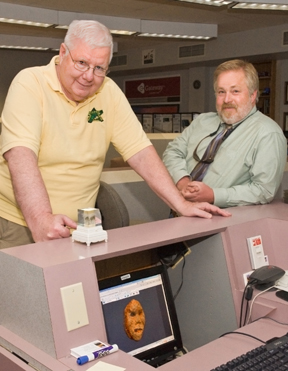Idaho State University lands grant to build virtual museum exhibits for Idaho’s students, researchers and public
August 6, 2010
It used to be public school classes would take regular field trips to museums to broaden their students' horizons. Now, Idaho State University and partners will begin taking virtual, online museum exhibits to the schools.
"This will bring the collections alive and make them accessible on a broad scale," said Herb Maschner, director of the Idaho Museum of Natural History and one of the grant's co-principal investigators. "The big goal here is to bring Idaho history, culture and natural history to life for people who can’t visit our collections, sharing the knowledge, research and expertise of Idaho State University’s growing scientific community."
 Researchers in the ISU Museum of Natural History, and Informatics Research Institute as well as the departments of anthropology and history have received a $135,000 Idaho State Board of Education Technology Incentive Grant. The grant will create a variety of online "education modules" that will provide multi-media, comprehensive exhibits to Idaho K-12 and university students, as well as to researchers and the general public – to anyone who has a computer and Internet access.
Researchers in the ISU Museum of Natural History, and Informatics Research Institute as well as the departments of anthropology and history have received a $135,000 Idaho State Board of Education Technology Incentive Grant. The grant will create a variety of online "education modules" that will provide multi-media, comprehensive exhibits to Idaho K-12 and university students, as well as to researchers and the general public – to anyone who has a computer and Internet access.
Idaho State University is collaborating on this project with the Idaho National Laboratory, Idaho State Historical Society and the Herrett Center for Arts and Science, a non-profit museum on the main campus of the College of Southern Idaho.
This project combines recent developments in 3-D scanning and database technologies developed at ISU to create opportunities for the implementation of virtual museum collections.
"We're using the technology we developed working on 'The Virtual Zooarchaeology of the Arctic Project,' which was funded by a $310,000 grant from the National Science Foundation," said Corey Schou, director of the ISU Informatics Research Institute and the Principal Investigator on the project. "That technology has been termed revolutionary by some of our colleagues (an article on VZAP is coming out soon in The Journal of Archeological Science; visit http://bones.iri.isu.edu/ to view examples of how the software can work) and we can use it to present a broad range of online educational modules."
This project is designed to better serve underrepresented and geographically separated communities and to increase access to critical Idaho history and culture courses. Scanning, imaging and information management tools within the Informatics Research Institute (IRI) and the Idaho Virtualization Laboratory (IVL), both housed at Idaho State University, will be used to create a suite of virtual museum educational modules and collections for the presentation of Idaho history, culture, archaeology and geography.
"We're building a museum where you can interact with everything," Schou said. "We've created the working virtual prototype that can display images and other materials online in 3-D that you can interact with. We have already created the database and search engine required to use it. With many of these online objects you can examine them as if you were holding them in your hand, turning them around and examining specific features. The potential applications for the virtual museum are many."
Maschner, Schou and their colleagues envision creating multi-faceted information modules on specific subjects, on, for example, the Lewis and Clark expedition or on the history of the Idaho National Laboratory. For a Lewis and Clark exhibit, online users could view video of history professors or curators talking about the expedition, view 3-D images of artifacts such as saddles, hats, headdresses, pieces of clothing, rifles, and bows and arrows from the time. It could have links to information about natural history of many of the animals and plants the expedition encountered, which might feature films of buffalo, links to 3-D images of animal skulls and maps of the historic range of different animals.
"We're grateful for the foresight the Idaho State Board of Education is displaying in awarding us this Technology Incentive Grant," Maschner said. "We are confident that the investment in this interdisciplinary project will be of great educational benefit to the state."
Richard Holmer, chair of the ISU Department of Anthropology, and Laura Woodworth-Ney, ISU associate vice president for academic affairs, are also co-principal investigators on the project.
###
Categories:
